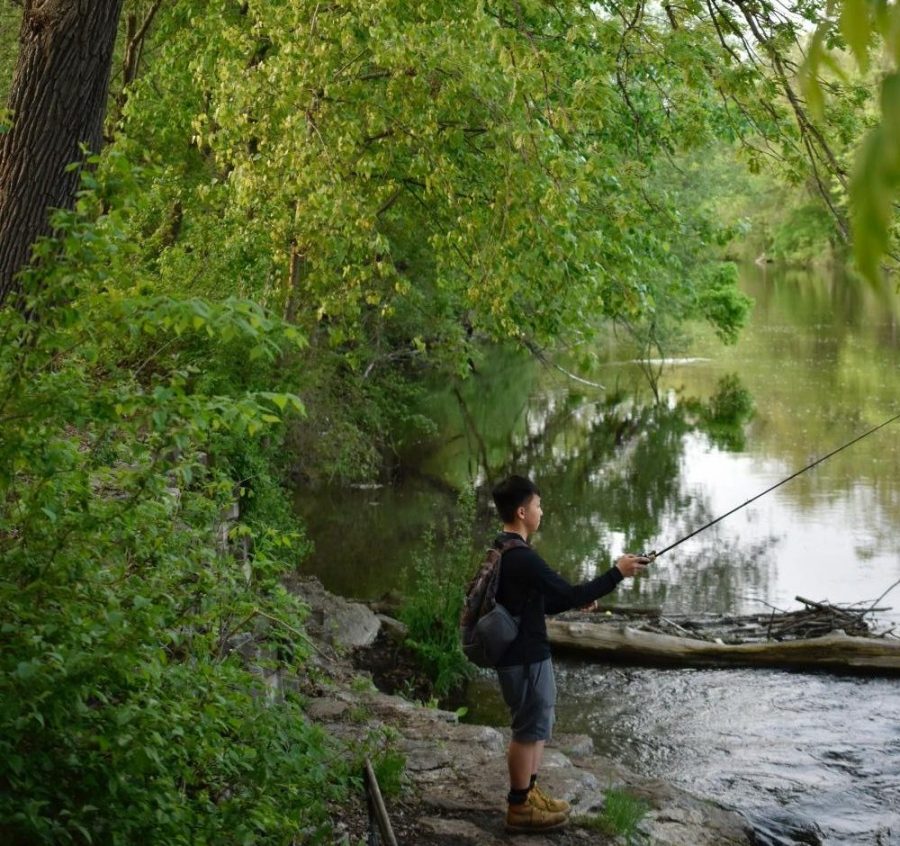Community discusses river access
A young fisherman tries his luck under a disputed oak tree. Kletszch Park is home to many such trees, some may be over 200 years old.
Developers from the Milwaukee County Parks system are planning designs for construction that will bring about repairs and new structures for the Kletzsch Park dam on the Milwaukee River.
The project’s objectives include repairing the dam, replacing degraded kayak and canoe portage, improving access to the river for people with disabilities, creating a viewing area and overlook and providing a fish passage for native fish species to get around the dam.
Parks officials held a meeting in Glendale on Jan. 9 to inform citizens of their proposal and display concept drawings. Over 100 people attended.
“We showed a concept for a fish passage option that, according to the hydraulic modeling that was done, could be constructed… on the west bank, and would allow passage [for native fish species],” said Therese Gripentrog, landscape architect and Parks representative for the project. “We definitely heard from people who were interested in having a fish passage and support the project. There were some people who were very concerned about losing oak trees at the overlook site and where the fish passage would have been built.”
The project team is considering reusing the wood from the oaks for benches, signs, or railings should they decide to cut the trees down.
Jacob Friend, senior, visits the park several times a week. He is opposed to the removal of the trees.
“Those oaks are super important because they are one of the few remnants of the oak savannah that used to be here,” Friend said.
Martha Bergland, Glendale resident and member of the Glendale Natural Heritage Committee (GNHC), is also in opposition.
“We [the GNHC] are completely opposed to the removal of ten old oak trees, some of which are probably as old as the state of Wisconsin, and also the removal of 30 feet deep of the bluff, because this is all in Indian Prairie [which] is one of the most important Indian ceremonial sites in the county certainly and in the area,” Bergland said.
Kletzsch Park was once a burial and ceremonial site for Native Americans. Some of the concerns that Bergland and others have is that construction will destroy historic Native American ceremonial structures.
“It’s not just the trees, though the trees are significant; it’s not just that we don’t need any more pavement in this world, but that this is a historic and ceremonial site that we should at least recognize in this area,” Bergland said.
According to a FAQ document released by the Parks system, an archaeologist contracted to survey the site found that the Native American mounds and significant resources identified in naturalist Increase Lapham’s records from the 1800s are outside of the proposed construction area. In addition, an archaeologist has completed the on-site investigations the state requires.
Mark D. Olsen, report writer and researcher, writes in a report that he thinks that further investigation is still required.
“While the intaglio [an engraved design] prairie is not under immediate threat of development, these intaglio features are so rare they deserve consideration as part of a long term planning process,” Olsen said in his report. “Magnetic gradiometer techniques have been perfected… in recent years to help relocate buried pit-like features such as [those that] might still exist at the Indian Prairie… [this area] should remain unaltered until proper non-intrusive investigations can be carried out.”
Friend thinks that a fish passage would be ineffective. He thinks a better solution for the ecosystem is to remove the dam, allowing the river to return to its natural flow and erosion rate. According to Friend, since the removal of the Estabrook dam, there has been a sharp increase in fish populations at Estabrook and has been a reappearance of beavers and mink.
“I believe that this thing that we’re talking about here to introduce a fish passageway… they’re trying to make it more attractive to the person that’s just looking to go down there and just have a good time,” Friend said. “But at the same time, it’s also taking away things from an ecosystem that are really valued… in the long term it will take away from the ecological benefits and the biodiversity of that area, and because of the loss of the ecological benefits of that area, the human benefits will also be lost in that area.”
Bergland is not opposed to a passage but thinks it should be built elsewhere.
“I’m not opposed to the fish passage at all, and none of us are. As a matter of fact, we’re working on a way to put it on the east bank of the river. And there are a lot of people working on the property rights and the legality of all of that and and we’re close to having a kind of a real possibility that we can offer the county,” Bergland said.
The developers prefer the west bank over the east for a number of reasons. For example, the FAQ document says that building on the west bank would allow the park staff unrestricted access to maintain the passage since the passage would be located in public park land, which is more limited on the east bank. It also says that building on the east bank would disturb the wetlands downstream.
“No one likes to lose trees, and especially mature trees in this case… So we listened to what people were telling us at the public meeting, and we have spent the last few months working with our consultant to develop some additional options for the location of the fish passage,” Gripentrog said.
“We are considering other locations, other alternatives,” said Karl Stave, engineer and project manager. “The thing that we have to make sure the other alternatives do is work from a hydraulic standpoint, that the fish could be efficiently passed through the bypass and that it won’t affect the flood point to the degree that we can’t build it. That’s been a struggle, to find that, those alternatives, and so we’re diligently working to find out what options are out there and then we’ll be presenting in a future public information what our findings are as far as other alternatives.”
The Parks system will hold another public information meeting when the project team finishes refining their original design.
“It’s been a challenge and we’re appreciative of people with interest sharing their thoughts,” Stave said.


